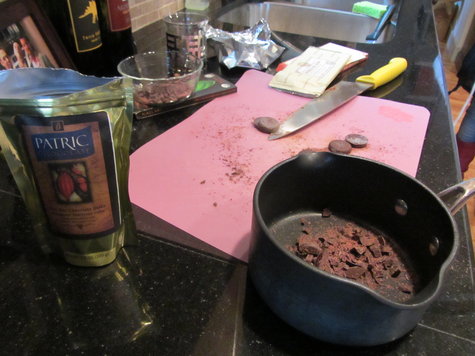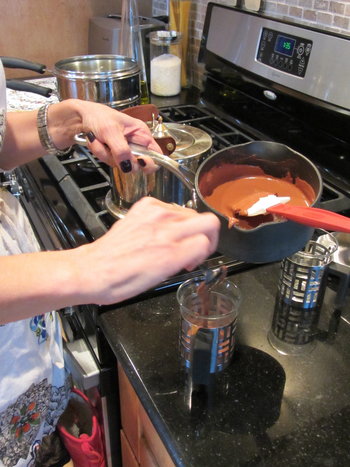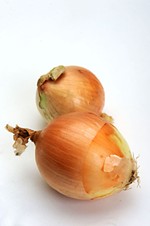A Visit with Madame Cocoa
Local chocolate maven loves to share her knowledge
By Margaret Shugart, 1:00PM, Sat. Jan. 19, 2013
Her kitchen is a world of chocolate. Laid out on the table are brightly wrapped bars from all over the world and a jar of roasted cocoa beans. The walls are covered with posters from chocolate makers and the cutting board on the counter was covered in chopped cocoa drops. Her eyes were bright and her smile playful as she approached her workstation.

“I am going to make us some hot chocolate while we talk, to show you something, and also so I can keep my hands busy.” The chopped chocolate was from Good Food Award-winning Patric Chocolates, created by Alan “Patric” McClure, a small producer out of Missouri. This particular chocolate was fashioned out of single-source beans from Madagascar.
She opened the bag and had me smell its intense aromas, then told a story about her first “chocolat chaud” or French hot chocolate. She melted the chocolate directly on the stove and slowly added half and half, a touch of water, and let me add my own sugar at the end, just as they do in France. The drink was so rich and delicious, I got goosebumps.

When I first met Adrienne Newman, she introduced herself as Madame Cocoa and described herself as a sort of sommelier of chocolate: a taster, an appreciator, and an educator. One cornerstone of that teaching is the difference between chocolate makers and chocolatiers. Chocolate makers make the substance we call chocolate, straight from the beans. It is a hot, messy, mechanical ordeal and many chocolate makers are engineer-minded people, able to work with and fix their own equipment (often machines from the 1880’s), and perform the very particular math required for a quality product. Chocolatiers take that product and make confections from it: truffles, pastries, and candies. We think of Europe as having the best chocolate makers in the world, but actually Americans started the trend of artisan chocolate from the bean. Although there are some waves of change, European chocolate shops are primarily chocolatiers, sourcing their base product from one or two large chocolate makers out of France and Belgium. It is a very important distinction.
The small American chocolate makers, creating bars from single-origin beans, are the artisans who fuel Adrienne’s passion. “It is the same with wine as it is with chocolate: the hand of the maker and the hand of the farmer and the location in which it is grown has so much to do with what you finally taste. When I found that out, it was too fascinating to not look into it more.”

Adrienne comes from a family of Dairy Queen owners. Both her parents and her grandparents ran franchise stores, and she said there were always desserts around- every night for dinner, something sweet in the morning, and after school. She never thought much about the origins of these sweets. Chocolate was just something given to her. But then she read the book Sweets: A History of Candy by Tim Richardson and the chapter on the chocolate changed her perspective. She began attending international conferences on sweets and finally left her job to travel for two years around Europe, developing her own personal chocolate tours and seeking out “the little guys… old-world style shops with jewel-like confections.” It was during this time that she discovered the trend of artisan chocolate making back home. “Here, you can have the best in the world for under $10. Some of the finest things being done in the world are being done in America. And it makes you so happy. It’s such a travesty for people not know it’s out there.”
American chocolate is not just about flavor and nuance and quality, it is also about human rights. Many small chocolate makers in the United States go beyond fair trade practices and travel directly to cocoa bean farms and buy straight from the growers. Missouri chocolate maker Shawn Askinosie left his job as a defense lawyer to become a chocolate craftsman, building his business from direct-source beans. He not only pays above fair trade prices for his beans, he involves the farmers in profit-sharing and provides instruction the best growing methods and post-harvest techniques. These practices guarantee he will have the best product possible, and also ensure that the money goes to the farmers and not a middleman. Take note that Shawn Askinosie will be in Austin on Feb. 7th to present a chocolate class at Antonelli's Cheese Shop (4220 Duvall). For more details about that class and to purchase tickets, go here.
Adrienne shares this passion for the small farmers. Hanging in her office are several maps, highlighting chocolate growing regions, all located within 20 degrees of the equator, north and south. She says her dream is to one day visit these locations and farms, and to tell the stories of the growers.

Saving the best for last, she showed me two important bars from Tejas Chocolate made by Scott and Michelle Moore, the first artisan chocolate makers in Texas. Scott and Michelle are located in Spring, Texas. They make their bars from single-source beans, roasting them in a “uniquely Texan” way, in their handmade solid clay brick oven. Both bars are powerful, rich, silky, and complex with different flavors emerging as they move around the tongue.

Tejas chocolate is currently only available in the Spec's store in downtown Houston, or online through their website, but Adrienne says they do have plans to start spreading across the state.
In addition to presenting Chocolate 101 through the Informal Classes at the University of Texas, Madame Cocoa leads Dessert First! walking tours through Central Austin on Saturdays from 2-6pm. They start from $39 (all inclusive) and sound like an educational, fun, and delicious way to explore sweet vendors in the city. Be sure to check back here for a report on the tours after we join one ourselves at the end of the month!
A note to readers: Bold and uncensored, The Austin Chronicle has been Austin’s independent news source for over 40 years, expressing the community’s political and environmental concerns and supporting its active cultural scene. Now more than ever, we need your support to continue supplying Austin with independent, free press. If real news is important to you, please consider making a donation of $5, $10 or whatever you can afford, to help keep our journalism on stands.
Dec. 6, 2013
Madame Cocoa, chocolate sommelier Adrienne Newman, Madame Cocoa, Adrienne Newman, Shawn Askinosie, Antonelli's Cheese Shop, chocolate maker, chocolatier, fair trade, Tejas Chocolates, Scott and Michelle Moore, University of Texas Informal Courses, Chocolate 101, Dessert First








